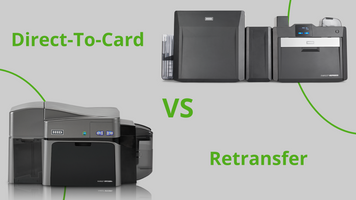Comparing ID Card Printers: Direct-to-Card vs. Retransfer
8th Aug 2024
ID cards are essential for various purposes including access control, employee identification, and secure transactions. Selecting the right printer technology is key to producing these cards effectively. At ProxCards, we aim to guide you through this decision by breaking down the differences between Direct-to-Card (DTC) and Retransfer printers. This guide will explore how each type of printer works, their advantages and drawbacks, and the best applications for each.
Direct-to-Card (DTC) Printers
How They Work
Direct-to-Card printers, also known as dye-sublimation printers, print directly onto the card's surface. The print head transfers ink from a ribbon onto the card, using heat to bond the ink to the card.
Advantages
- Cost-Effective: DTC printers typically have a lower initial cost and reduced operating expenses compared to retransfer printers.
- Speed: They are capable of quickly printing cards, making them suitable for high-volume production.
- Compact Size: These printers are often smaller and more portable, fitting easily in various office settings.
- Ease of Use: Most DTC printers are straightforward to operate and require minimal training.
Disadvantages
- Print Quality: Generally, the print quality may not match that of retransfer printers, with possible visible lines or streaks.
- Edge-to-Edge Printing: DTC printers may leave a small, unprinted border around the edges of the card.
- Card Compatibility: They are less effective with uneven surfaces or cards with embedded chips, as the print head needs a smooth, flat surface.
Ideal For
- Employee Badges: Efficient and affordable for producing employee ID cards.
- Membership Cards: Suitable for clubs and organizations needing to print large quantities quickly.
- Visitor Passes: Great for temporary passes due to their fast printing speed and lower cost.
Retransfer Printers
How They Work
Retransfer printers utilize a two-step process. First, an image is printed onto a clear film, which is then thermally bonded to the card's surface. This method allows for high-quality, edge-to-edge printing.
Advantages
- Superior Print Quality: Retransfer printers produce high-resolution, photo-quality images with vibrant colors and sharp details.
- Edge-to-Edge Printing: Capable of printing across the entire surface of the card, including the edges.
- Versatility: Can print on uneven surfaces, including smart cards and cards with embedded chips.
- Durability: The film layer adds protection, making the cards more resilient to wear and tear.
Disadvantages
- Higher Cost: Retransfer printers have a higher initial cost and greater consumable expenses.
- Slower Print Speed: The additional printing steps result in longer production times per card.
- Size and Complexity: Typically larger and more complex to operate, requiring more space and training.
Ideal For
- High-Security IDs: Perfect for government IDs, driver’s licenses, and other high-security cards due to their superior quality and durability.
- Corporate Badges: Suitable for companies that need professional-looking badges with advanced security features.
- Gift Cards: High-quality and durable, making them ideal for creating gift cards that reflect the brand’s image.
Choosing the Right Printer
The choice between DTC and retransfer printers depends on your specific requirements:
- Budget-Friendly and High-Volume Needs: If cost and speed are your main concerns, a DTC printer is likely your best option. It’s ideal for situations where large volumes of cards need to be produced quickly and the highest quality is not a priority.
- Quality and Durability Needs: For high-definition, durable cards that can handle heavy use and are printed on varied surfaces, a retransfer printer is worth the investment. This is especially true for organizations where the ID card is a critical component of their security system.
At ProxCards, we recognize that each organization has unique needs. By understanding the features and limitations of Direct-to-Card and Retransfer printers, you can make an informed choice that best fits your operational needs and budget. Contact us today for more information or to discuss your specific ID card printing requirements.

